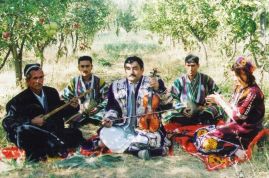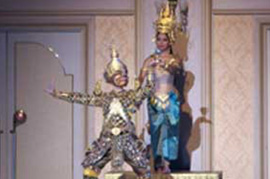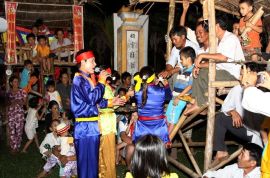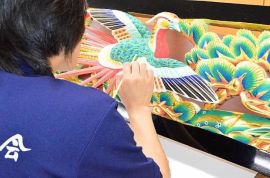LEARN ABOUT ICH
WHAT IS INTANGIBLE CULTURAL HERITAGE (ICH) ?
ICH is living cultural heritage. Although it transforms over time, it is transmitted from generation to generation and gives us cultural identity and richness thus enhancing social cohesion.
In the text of the United Nations Educational, Scientific and Cultural Organization (UNESCO) 2003 Convention (Article 2(2)), the following five types of ICH are included:
- ORAL TRADITIONS AND EXPRESSIONS
-

Falak, traditional folklore music (Tajikistan)
© Tajikistan National Commission for UNESCO, 2020, with the permission of UNESCO

Pantun, a form of Malay verse (Indonesia, Malaysia)
© Policy Research Center of Education and Culture, Ministry of Education and Culture, Indonesia, 2017, with the permission of UNESCO
- PERFORMING ARTS
-

Royal ballet of Cambodia (Cambodia)
© International Research Centre for Intangible Cultural Heritage in the Asia-Pacific Region (IRCI), 2013

The art of Bài Chòi in Central Viet Nam (Viet Nam)
© Vietnamese Institute for Musicology, 2014, with the permission of UNESCO
- SOCIAL PRACTICES, RITUALS AND FESTIVE EVENTS
-

Kumbh Mela, pilgrimage and festival in Hinduism (India)
© Sanjay Jagtap, India, 2015, with the permission of UNESCO

Hawker culture in Singapore, community dining and culinary practices in a multicultural urban context (Singapore)
© National Environment Agency, Singapore, 2019, with the permission of UNESCO
- KNOWLEDGE AND PRACTICES CONCERNING NATURE AND THE UNIVERSE
-

Carolinian wayfinding and canoe making (Federated States of Micronesia)
© Eric Metzgar (USA), Micronesia, 2016, with the permission of UNESCO

Falconry, a living human heritage (Kazakhstan, Republic of Korea, Krygyzstan, Mongolia, etc.)
© National Commission of the Kyrgyz Republic for UNESCO, 2019, with the permission of UNESCO
- TRADITIONAL CRAFTSMANSHIP
-

Tais, traditional textile
© Timor-Leste National Commission for UNESCO, 2020, with the permission of UNESCO

Traditional skills, techniques and knowledge for the conservation and transmission of wooden architecture in Japan
© Agency for Cultural Affairs, Japan, 2019, with the permission of UNESCO
Oral traditions and expressions comprise a wide variety of verbal forms, including proverbs, riddles, tales, nursery rhymes, legends, myths, epic songs and poems, charms, prayers, chants, songs, dramatic performances, and more. They are used to pass on knowledge, cultural and social values, and collective memory through word of mouth.
PERFORMING ARTS
Performing arts include numerous cultural expressions that reflect human creativity, ranging from vocal and instrumental music, dance, and theatre to pantomime, sung verse, and beyond. They can be found in many other intangible heritage domains, such as rituals, festive events, and oral traditions.
SOCIAL PRACTICES, RITUALS AND FESTIVE EVENTS
Social practices, rituals and festive events are habitual activities that structure the lives of communities and groups and that are shared by and relevant to many of their members. They involve a wide variety of forms: worship rites; rites of passage; birth, wedding and funeral rituals; oaths of allegiance; traditional legal systems; traditional games and sports; kinship and ritual kinship ceremonies; settlement patterns; culinary traditions; seasonal ceremonies; practices specific to men or women only; hunting, fishing and gathering practices and many more.
KNOWLEDGE AND PRACTICES CONCERNING NATURE AND THE UNIVERSE
Knowledge and practices concerning nature and the universe refer to traditional knowledge, know-how, skills, practices, and representations developed by communities through their interactions with the natural environment. They include traditional ecological wisdom, indigenous knowledge, knowledge about local fauna and flora, traditional healing systems, rituals, beliefs, initiatory rites, cosmologies, shamanism, possession rites, social organizations, festivals, languages, and visual arts. They also strongly influence values and beliefs and underlie many social practices and cultural traditions. They, in turn, are shaped by the natural environment and the community’s wider world.
TRADITIONAL CRAFTSMANSHIP
Traditional craftsmanship focuses on the skills and knowledge involved in creating crafts rather than the craft products themselves. This domain encompasses a variety of expressions: tools; clothing and jewellery; costumes and props for festivals and performing arts; storage containers, objects used for storage, transport and shelter; decorative art and ritual objects; musical instruments and household utensils, and toys, both for amusement and education.
—————
Instances of intangible cultural heritage are not limited to a single manifestation and many include elements from multiple domains. The boundaries between domains are extremely fluid and often vary from community to community. It is difficult, if not impossible, to impose rigid categories externally.
ABOUT UNESCO
The United Nations Educational, Scientific and Cultural Organization (UNESCO) was founded in 1945 for the purpose of promoting international collaboration in the fields of education, science, culture, and communication.
UNESCO’S CONVENTION FOR THE SAFEGUARDING OF THE INTANGIBLE CULTURAL HERITAGE
Among a total of seven conventions of UNESCO regarding culture, is the Convention for the Safeguarding of the Intangible Cultural Heritage (the 2003 Convention), which was adopted in 2003, and which aims to preserve and protect intangible cultural heritage.
The 2003 Convention was the outcome of discussions held at UNESCO since the 1950s for the purpose of safeguarding folklore, including oral traditions and folk arts. The Convention has four objectives: (1) to safeguard intangible cultural heritage; (2) to ensure respect for the intangible cultural heritage of the communities, groups and individuals concerned; (3) to raise awareness at the local, national and international levels of the importance of intangible cultural heritage; and (4) to provide for international cooperation and assistance.
The 2003 Convention takes the standpoint of valuing all intangible cultural heritage equally. It focuses on the practitioners’ daily lives in relation to ICH, and thus encourages the participation of communities to which the practitioners belong. This underlying notion reflects the idea that the people are the ones that play a crucial role in ICH overall – in creating, recreating, maintaining and transmitting the treasures of humanity.
Many member states that have ratified the 2003 Convention currently suffer from poverty, low rates of literacy, a lack of experts, a lack of interest among young people, urbanisation, conflict, and war. For this reason, assistance in developing legal systems, in the training of human resources, financial assistance, sustainable education, and similar areas are perceived necessary.
LEARNING MATERIALS
VIDEO FEATURES
-
Osaka, 29 November 2017
Co-organised by IRCI, the National Ethnology of Museum (Japan), and the Agency for Cultural Affairs (Japan)
-
Osaka, 19 November 2016
Co-organised by IRCI, Sakai City, and the Agency for Cultural Affairs (Japan) In cooperation with the Ministry of Foreign Affairs (Japan), the Japanese National Commission for UNESCO, and the Japan Art Council (National Bunraku Theatre)
-
The Training Course for the Safeguarding of ICH 2011
Tokyo, Osaka, and Shiga, Japan, 1-5 February 2011
Co-organised by the National Research Institute for Cultural Properties, Tokyo In cooperation with the National Museum of Ethnology Supported by the Japanese National Commission for UNESCO



